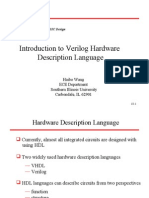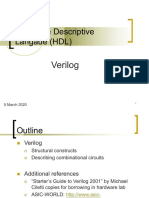Module #10 - Functions
Uploaded by
VLSI Excellence - Gyan Chand DhakaModule #10 - Functions
Uploaded by
VLSI Excellence - Gyan Chand DhakaModule #10 : Verilog HDL Functions
10.1: Verilog HDL Function :
- Functions are declared within a module, and can be called from continuous assignments, always
blocks, or other functions.
- In a continuous assignment, they are evaluated when any of its declared inputs change.
- In a procedure, they are evaluated when invoked.
- Functions describe combinational logic, and do not generate latches.
- Functions are a good way to reuse procedural code, since modules cannot be invoked from within a
procedure.
26-11-2022 VLSI Excellence - Gyan Chand Dhaka 1
Module #10 : Verilog HDL Functions
10.2: Function Declaration :
- A function declaration specifies the name of the function, the width of the function return value, the
function input arguments, the variables (reg) used within the function, and the function local parameters
and integers
Syntax: Example 10.1:
function [msb:lsb] function_name; function [7:0] my_func; // function return 8-bit
input [msb:lsb] input_arguments; value
reg [msb:lsb] reg_variable_list; input [7:0] i;
parameter [msb:lsb] parameter_list; reg [4:0] temp;
integer [msb:lsb] integer_list; integer n;
... statements ... temp= i[7:4] | ( i[3:0]);
endfunction my_func = {temp, i[[2:0]};
endfunction
26-11-2022 VLSI Excellence - Gyan Chand Dhaka 2
Module #10 : Verilog HDL Functions
10.3: Function Return Value:
- When we declare a function, a variable is also implicitly declared with the same name as the function
name, and with the width specified for the function name (The default width is 1-bit).
- At least one statement in the function must assign the function return value to this variable.
10.4. Function Call:
- A function call is an operand in an expression. A function call must specify in its terminal list all the
input parameters.
Example 10.2:
wire [7:0] x;
wire [7:0] y;
assign y = my_func[x];
26-11-2022 VLSI Excellence - Gyan Chand Dhaka 3
Module #10 : Verilog HDL Functions
10.5: Function Return Value:
- Functions must contain at least one input argument.
- Functions cannot contain an inout or output declaration.
- Functions cannot contain time controlled statements (#, @, wait).
- Functions can invoke other functions, but not themselves (not recursive).
- Functions cannot invoke tasks.
- Functions must contain a statement that assigns the return value to the implicit function name register.
26-11-2022 VLSI Excellence - Gyan Chand Dhaka 4
Module #10 : Verilog HDL Functions
10.6: Function Example:
- A Function has only one output. If more than one return value is required, the outputs should be
concatenated into one vector before assigning it to the function name.
- The calling module program can then extract (unbundle) the individual outputs from the concatenated
form.
Example 10.3:
module simple_processor (instruction, outp);
input [31:0] instruction;
output [7:0] outp;
reg [7:0] outp;; // so it can be assigned in always block
reg func;
reg [7:0] opr1, opr2;
26-11-2022 VLSI Excellence - Gyan Chand Dhaka 5
Module #10 : Verilog HDL Functions
Continued . . .
function [16:0] decode_add (instr) end
// returns 1 1-bit plus 2 8-bits 8’b10001010: begin // increment operand
input [31:0] instr; add_func = 1;
reg add_func; opr2 = 8’b00000001;
reg [7:0] opcode, opr1, opr2; end
begin default: begin; // decrement operand
opcode = instr[31:24]; add_func = 0;
opr1 = instr[7:0]; opr2 = 8’b00000001;
case (opcode) end
8’b10001000: begin // add two operands endcase
add_func = 1; decode_add = {add_func, opr2, opr1}; // concatenated
opr2 = instr[15:8]; into 17-bits
end end
8’b10001001: begin // subtract two operands endfunction
add_func = 0;
opr2 = instr[15:8];
26-11-2022 VLSI Excellence - Gyan Chand Dhaka 6
Module #10 : Verilog HDL Functions
Continued . . .
always @(instruction) begin
{func, op2, op1} = decode_add (instruction); //
outputs unbundled
if (func == 1)
outp = op1 + op2;
else
outp = op1 - op2;
end
endmodule
26-11-2022 VLSI Excellence - Gyan Chand Dhaka 7
You might also like
- Nism X A - Investment Adviser Level 1 - Last Day Revision Test 3 PDF40% (5)Nism X A - Investment Adviser Level 1 - Last Day Revision Test 3 PDF42 pages
- Rabonni Sonatas For Flute and Piano Nr. 13-24 - Piano Only (Book2)100% (1)Rabonni Sonatas For Flute and Piano Nr. 13-24 - Piano Only (Book2)69 pages
- How To Achieve 99% Quality Backtests in MetaTrader 4No ratings yetHow To Achieve 99% Quality Backtests in MetaTrader 416 pages
- Task and Functions: Vinchip Systems ChennaiNo ratings yetTask and Functions: Vinchip Systems Chennai21 pages
- Task and Functions: Vinchip Systems ChennaiNo ratings yetTask and Functions: Vinchip Systems Chennai21 pages
- Digital System Design: Verilog HDL Tasks and FunctionsNo ratings yetDigital System Design: Verilog HDL Tasks and Functions24 pages
- High Level Digital Design & Testing (HLDDT)No ratings yetHigh Level Digital Design & Testing (HLDDT)126 pages
- EE434 ASIC & Digital Systems: Partha Pande School of EECS Washington State University Pande@eecs - Wsu.eduNo ratings yetEE434 ASIC & Digital Systems: Partha Pande School of EECS Washington State University Pande@eecs - Wsu.edu29 pages
- Advanced_VLSI_Modified_Presentation (1)No ratings yetAdvanced_VLSI_Modified_Presentation (1)15 pages
- L05 - Verilog - Operators Instantiation ParametrizationNo ratings yetL05 - Verilog - Operators Instantiation Parametrization30 pages
- Design of Embedded Processors: Version 2 EE IIT, Kharagpur 1No ratings yetDesign of Embedded Processors: Version 2 EE IIT, Kharagpur 119 pages
- Design of Embedded Processors: Version 2 EE IIT, Kharagpur 1No ratings yetDesign of Embedded Processors: Version 2 EE IIT, Kharagpur 119 pages
- Introduction To Verilog HDL: Presented by K.SwathiNo ratings yetIntroduction To Verilog HDL: Presented by K.Swathi35 pages
- Chapter 2d - Verilog HDL Module Instantiation, Task FunctionNo ratings yetChapter 2d - Verilog HDL Module Instantiation, Task Function21 pages
- Enc=Encoded=u3vRnRqnBbkfZFAt7kLCbTdTjQGi5MlUhP4vD141AylmhQg3Psh6DTfP09G8No ratings yetEnc=Encoded=u3vRnRqnBbkfZFAt7kLCbTdTjQGi5MlUhP4vD141AylmhQg3Psh6DTfP09G833 pages
- Verilog Session: General Introduction To Verilog HDL: EE282 Spring Quarter, 2001-2002No ratings yetVerilog Session: General Introduction To Verilog HDL: EE282 Spring Quarter, 2001-200211 pages
- ENEL111 Digital Electronics: Richard Nelson G.1.29No ratings yetENEL111 Digital Electronics: Richard Nelson G.1.2938 pages
- Red Pitaya - FPGA Ebook Part 2 - Basics of Verilog FPGA Programming LanguageNo ratings yetRed Pitaya - FPGA Ebook Part 2 - Basics of Verilog FPGA Programming Language16 pages
- Verilog_Control_Structures_and_OperatorsNo ratings yetVerilog_Control_Structures_and_Operators4 pages
- Experiment No 01.: Aim: Develop A Javascript To Use Decision Making and LoopingNo ratings yetExperiment No 01.: Aim: Develop A Javascript To Use Decision Making and Looping6 pages
- The-Hound-of-the-Baskervilles 2-Chapter 2No ratings yetThe-Hound-of-the-Baskervilles 2-Chapter 214 pages
- Exercise 8 Polymerase Chain Reaction: Cell and Molecular Biology LaboratoryNo ratings yetExercise 8 Polymerase Chain Reaction: Cell and Molecular Biology Laboratory7 pages
- Declaration of Heirship and Sale - EnclonarNo ratings yetDeclaration of Heirship and Sale - Enclonar2 pages
- Measuring Profitability and Financial Position On The Financial Statements Chapter 4100% (1)Measuring Profitability and Financial Position On The Financial Statements Chapter 466 pages
- B.E. Civil Engineering Semester: VII Subject Name: Construction Management & Equipment Subject Code: (CV 702) A. Learning ObjectivesNo ratings yetB.E. Civil Engineering Semester: VII Subject Name: Construction Management & Equipment Subject Code: (CV 702) A. Learning Objectives5 pages
- Sol. Man. - Chapter 10 - She (Part 1) - 2021No ratings yetSol. Man. - Chapter 10 - She (Part 1) - 202118 pages
- Nism X A - Investment Adviser Level 1 - Last Day Revision Test 3 PDFNism X A - Investment Adviser Level 1 - Last Day Revision Test 3 PDF
- Rabonni Sonatas For Flute and Piano Nr. 13-24 - Piano Only (Book2)Rabonni Sonatas For Flute and Piano Nr. 13-24 - Piano Only (Book2)
- How To Achieve 99% Quality Backtests in MetaTrader 4How To Achieve 99% Quality Backtests in MetaTrader 4
- Digital System Design: Verilog HDL Tasks and FunctionsDigital System Design: Verilog HDL Tasks and Functions
- EE434 ASIC & Digital Systems: Partha Pande School of EECS Washington State University Pande@eecs - Wsu.eduEE434 ASIC & Digital Systems: Partha Pande School of EECS Washington State University Pande@eecs - Wsu.edu
- L05 - Verilog - Operators Instantiation ParametrizationL05 - Verilog - Operators Instantiation Parametrization
- Design of Embedded Processors: Version 2 EE IIT, Kharagpur 1Design of Embedded Processors: Version 2 EE IIT, Kharagpur 1
- Design of Embedded Processors: Version 2 EE IIT, Kharagpur 1Design of Embedded Processors: Version 2 EE IIT, Kharagpur 1
- Introduction To Verilog HDL: Presented by K.SwathiIntroduction To Verilog HDL: Presented by K.Swathi
- Chapter 2d - Verilog HDL Module Instantiation, Task FunctionChapter 2d - Verilog HDL Module Instantiation, Task Function
- Enc=Encoded=u3vRnRqnBbkfZFAt7kLCbTdTjQGi5MlUhP4vD141AylmhQg3Psh6DTfP09G8Enc=Encoded=u3vRnRqnBbkfZFAt7kLCbTdTjQGi5MlUhP4vD141AylmhQg3Psh6DTfP09G8
- Verilog Session: General Introduction To Verilog HDL: EE282 Spring Quarter, 2001-2002Verilog Session: General Introduction To Verilog HDL: EE282 Spring Quarter, 2001-2002
- ENEL111 Digital Electronics: Richard Nelson G.1.29ENEL111 Digital Electronics: Richard Nelson G.1.29
- Red Pitaya - FPGA Ebook Part 2 - Basics of Verilog FPGA Programming LanguageRed Pitaya - FPGA Ebook Part 2 - Basics of Verilog FPGA Programming Language
- Experiment No 01.: Aim: Develop A Javascript To Use Decision Making and LoopingExperiment No 01.: Aim: Develop A Javascript To Use Decision Making and Looping
- Exercise 8 Polymerase Chain Reaction: Cell and Molecular Biology LaboratoryExercise 8 Polymerase Chain Reaction: Cell and Molecular Biology Laboratory
- Measuring Profitability and Financial Position On The Financial Statements Chapter 4Measuring Profitability and Financial Position On The Financial Statements Chapter 4
- B.E. Civil Engineering Semester: VII Subject Name: Construction Management & Equipment Subject Code: (CV 702) A. Learning ObjectivesB.E. Civil Engineering Semester: VII Subject Name: Construction Management & Equipment Subject Code: (CV 702) A. Learning Objectives

























































































